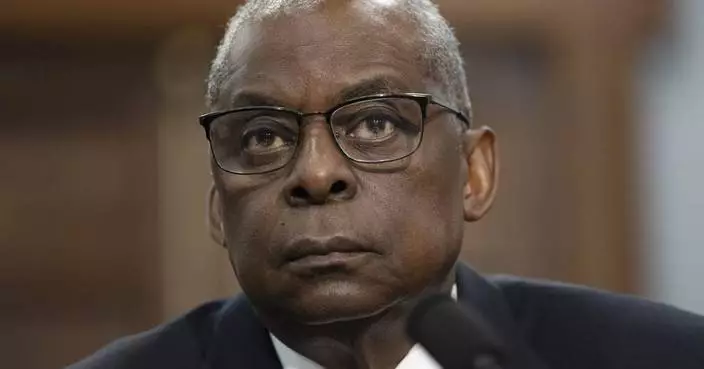President Donald Trump on Wednesday muddied the waters on America's withdrawal from Syria and the conditions on the ground there, as he distanced himself and the U.S. from the ongoing Turkish invasion into Syria.
He suggested incorrectly that the Syrian Kurds who fought alongside U.S. forces against the Islamic State group deliberately released IS prisoners and wrongly said Americans have been in the Syria conflict for 10 years.
A look at his claims:
U.S. INTERVENTION IN SYRIA
TRUMP: "We were supposed to be in Syria for one month. That was 10 years ago."
THE FACTS: The U.S.-led coalition began airstrikes on Islamic State militants in Syria in September 2014. About a year later, the Pentagon said that teams of special operations forces began going into Syria to conduct raids and begin efforts to partner with the Kurdish forces. Then-Defense Secretary Ash Carter made it clear to Congress at that time that the Pentagon was ready to expand operations with the Kurds and would continue to do so as to battle IS. There was no mention of a one-month timeline.
PRISON RELEASE
TRUMP: Speaking about IS detainees, Trump said: "People let some go. They opened a couple of doors to make us look as bad as possible." Later he described the IS detainees as "people that probably the Kurds let go to make a little bit stronger political impact."
THE FACTS: There is no indication that Kurdish forces, who fought IS for years with U.S. and coalition troops, deliberately opened prison doors to let militants out. According to U.S. and defense officials, fewer than 100 prisoners have escaped and Kurdish fighters are still guarding the prisons. Officials say that some of the Kurdish forces have moved north to fight the invading Turks, but many remain to secure the prisons, which hold about 2,000 foreign fighters and another 10,000 Iraqis and Syrians who fought with IS. Officials spoke on condition of anonymity to describe ongoing military operations.
LEAVING SYRIA
TRUMP: "Our soldiers are mostly gone from the area."
THE FACTS: Trump is correct that close to 30 U.S. troops moved out of two outposts near the border area where the Turkish attack was initially centered. But the bulk of the roughly 1,000 U.S. troops deployed to Syria are still in the country. According to officials, most of the U.S. troops have largely been consolidated into two locations in the north, including an airfield facility in the western part of the country known as the Kobani landing zone. A small number of troops left in recent days with military equipment, and more recently the withdrawal of forces began but so far not in large numbers. Officials say the withdrawal will take weeks.
COMING HOME
TRUMP: "It's time to bring our soldiers back home."
THE FACTS: This may have a bit of truth, because some of the U.S. forces in Syria could return home if their deployment is over. But, many will not. While the U.S. has begun what the Pentagon calls a deliberate withdrawal of troops from Syria, Trump himself has said that the 200-300 U.S. forces deployed to a southern Syria outpost in Al-Tanf will remain there. Also, while the U.S. forces are leaving Syria, that doesn't mean they are automatically coming home. Instead, military officials are developing plans to station U.S. forces in nearby locations, including Iraq and possibly Jordan, where they will still be able to monitor and, if needed, continue to conduct operations against IS.
WASHINGTON (AP) — Russia has moved some troops onto an airbase in Niger where a small number of U.S. forces remain, but Defense Secretary Lloyd Austin said he doesn't see it as a significant issue. Most American troops left that base in the nation's capital, Niamey, a U.S. official said.
The arrival of Russian trainers in the West African country about three weeks ago came in the wake of Niger’s decision to order out all U.S. troops. The order dealt a blow to U.S. military operations in the Sahel, a vast region south of the Sahara desert where groups linked to al-Qaida and the Islamic State group operate.
The Pentagon has said the U.S. troops will depart but has not provided a timeline.
When Russian troops arrived last month, it was unclear where they were staying. The Niamey base, Austin said late Thursday, is located at the capital city's Diori Hamani International Airport, and “the Russians are in a separate compound and don’t have access to U.S. forces or access to our equipment.”
He said the U.S. will continue to watch the situation but he doesn't see it as a significant force protection issue.
A U.S. official said the Russian forces are on the other side of the Niamey facility, known as Airbase 101, and that other international forces — such as the Germans and Italians — also reside. The official spoke on the condition of anonymity to discuss troop movements. It's unclear how many U.S. troops remain at the Niamey base.
The Russian presence on the base comes as tensions remain high between Washington and Moscow over the ongoing U.S. support for Ukraine's military.
About 1,000 U.S. troops are still in Niger, but the bulk of them moved to what's called Airbase 201 near Agadez, some 920 kilometers (550 miles) away from the capital, not long after mutinous soldiers ousted the country’s democratically elected president last July.
A few months later, the ruling junta asked French forces to leave and turned to the Russian mercenary group Wagner for security assistance.
In October, Washington officially designated the military takeover as a coup, which triggered U.S. laws restricting the military support and aid that it can provide to Niger. Since then, diplomatic efforts to restore ties with Niger have been unsuccessful.
Until recently, Washington considered Niger a key partner and ally in a region swept by coups in recent years, investing millions of dollars in the Agadez base, which has been critical to U.S. counterterrorism operations in the Sahel. The U.S. also has invested hundreds of millions of dollars in training Niger’s military since it began operations there in 2013.
The Pentagon also has said the U.S. will relocate most of the approximately 100 forces it has deployed in neighboring Chad for now. Chad is also considering whether to continue its security agreement with the U.S.
Maj. Gen. Pat Ryder, Pentagon press secretary, told reporters that the departure from Chad "is a temporary step as part of the ongoing review of our security cooperation, which will resume after Chad’s May 6th presidential election.”

FILE - Supporters of Niger's ruling junta gather for a protest called to fight for the country's freedom and push back against foreign interference, in Niamey, Niger, Aug. 3, 2023. Russia has moved some troops onto an airbase in Niger where a small number of U.S. forces remain after most American troops left the base in Niamey, the nation's capital, a U.S. official said Thursday, May 2, 2024. (AP Photo/Sam Mednick, File)










